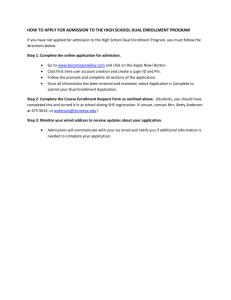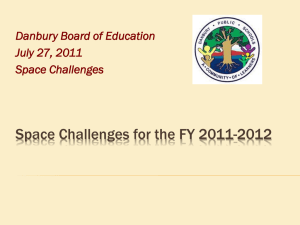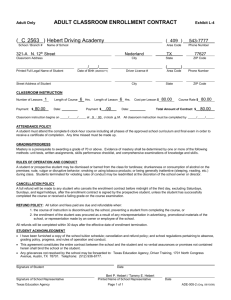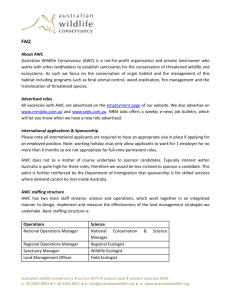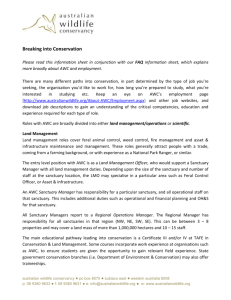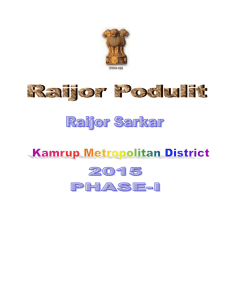Public Safety Institute Floor Plan Theater Remodel
advertisement
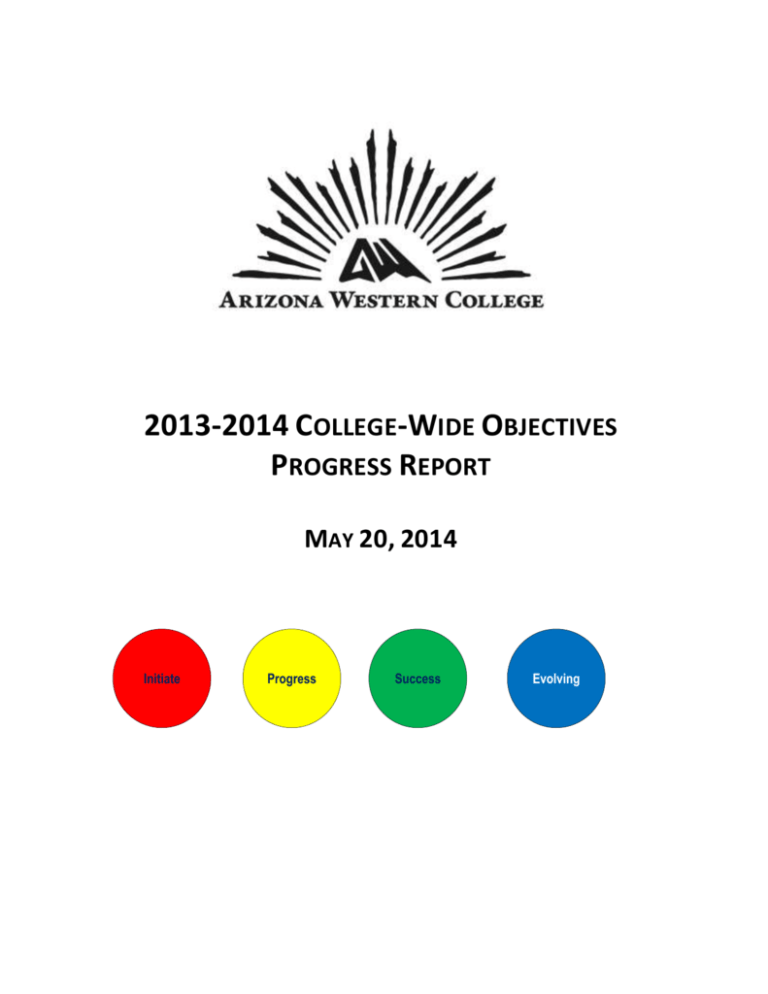
2013-2014 COLLEGE-WIDE OBJECTIVES PROGRESS REPORT MAY 20, 2014 Initiate Progress Success Evolving Aug 2013 Objective #1 – Sustained Enrollment Oct 2013 Jan 2014 Mar 2014 Develop a plan for sustained enrollment growth, with particular emphasis on specific demographic groups. Responsibility: Bryan Doak, Dean of Admissions and Enrollment Services Summary of Progress: Data and Decision Making: In order to have sustained enrollment growth Arizona Western College must continue to create a datarich environment focused upon developing and analyzing factual data to drive its decisions. Under the direction of Dr. Mary Schaal, The Office of Institutional Effectiveness, Research and Grants collects, analyzes and presents critical strategic data that drives many institutional decisions including end of term standard reports, annual fact book, employee satisfaction, student satisfaction and environmental scan of the community. The environmental scan provided critical information on student demographics. The criteria of the study included promoting a culture of inclusion to enhance enrollment with potential enrollment growth among lifelong learners and returning adults. Analysis of K-12 students, their test scores and the effects on enrollment were taken into account along with the growing demand of military in the area. Strategic Enrollment Management. The Strategic Enrollment Management Committee showed substantial growth to incorporate campus-wide involvement within a smaller collection of campus representation. Under the direction of President Dr. Glenn E. Mayle, the reorganization of the committee increased productivity and strategies implemented to reach more students. The exploration of data generated ideas including increased on-line courses, priority registration, waitlist for classes, 8, 12 and 16 week scheduling, social media and awarding institutional scholarships as key strategies to enhance enrollment growth. Partnerships. Ongoing collaboration of partnerships between Arizona Western College, Northern Arizona University, University of Arizona and Arizona State University has resulted in increased articulations from six to over one hundred within the last five years. These partnerships provide vitality for enrollment growth and stability for the institution and the community. Transfer sessions, field trips, social media and Transfer Fair weeks are resources for all students, at all campuses and the community. Testing Center. Arizona Western College Testing Center is a premier testing center recognized by College Board as one of the top 100 centers in the country. The Testing Center serves Yuma and La Paz county with General Education Development (GED) testing, College Level Examination Program (CLEP) and testing for city, county, state employers, and teacher certification, FBI and Homeland Security examinations. Over 1,475 GED candidates were tested last year. Past institutional research data show 30% of GED graduates attend Arizona Western College for at least one semester. E – Recruiter Ellucian Optimization Services. The implementation of Ellucian E-Recruiter, sanctioned by Arizona Western College District Governing Board and President Dr. Glenn E. Mayle, has allowed the institution to move into the 21 st century with admissions and enrollment processes. The enterprise wide system supports administrative functions that link prospective students the opportunity to apply on line. This process has stream lined effective communication with potential students. The continuation of Ellucian Optimization Services affords best practices regarding academic records, registration, curriculum management, financial aid, accounts receivable and finance. Other – Quality Faculty – We must continue to recruit and retain quality faculty for enrollment growth. Continued involvement from campus leadership from the entire District strengthens community ties. Mission and Goals – Maintain a clear mission and strong strategic goals that sustain and support enrollment growth. Marketing and Promotion – Continue to promote Arizona Western College at an affordable cost with quality education and superior learning objectives. 2013-2014 College Wide Objectives Progress Summary May 20, 2014 2 May 2014 Objective #2 – Higher Learning Commission Aug 2013 Oct 2013 Jan 2014 Mar 2014 May 2014 Continue the Higher Learning Commission Assessment Academy emphasis on student learning outcomes in General Education with a focus on student knowledge and skills in scientific literacy. Responsibility: Dr. Linda Elliott-Nelson, Dean of Instruction Summary of Progress: The AWC General Education Curriculum Committee published AWC General Education components and General Education Student Learning Outcomes in the AWC Catalog 2014-2015, pages 48-53. Scientific literacy was introduced to the faculty at large during the all-faculty meeting in August 2013, through the General Education poster and notebooks, published description, and through the Scientific Literacy poster designed by Dr. Megan Lahti. Scientific Literacy posters were distributed through the college district for exposure to students for recognition and discussion. Demonstrating the tie between Scientific Literacy and writing, a poster on Inquiry-Based Writing designed by Anne-Marie Thweatt was introduced at the January 2014 all-faculty meeting and distributed district-wide for student use and recognition. Students worked with inquirybased writing through ethnography assignments in English 101 and 102 courses, utilizing data creation and interpretation. Students have demonstrated scientific literacy-based learning outcomes through television production; the Southwest Agriculture Summit (February, 2014); Math-In-Nature presentations (October 2013), employing data to apply an understanding of quantitative reasoning; and presentations for the Student Showcase (April 30, 2014) and the Sustainability Fair (April 17, 2014). General Education assessment will continue to be discussed, planned, evolved, and measured by the college on a regular basis as part of our educational activities. 2013-2014 College Wide Objectives Progress Summary May 20, 2014 3 2013-2014 College Wide Objectives Progress Summary May 20, 2014 4 2013-2014 College Wide Objectives Progress Summary May 20, 2014 5 2013-2014 College Wide Objectives Progress Summary May 20, 2014 6 STUDENT APPLICATIONS • Student Showcase • AWC Television • Math in Nature • Southwest Agriculture Summit 2013-2014 College Wide Objectives Progress Summary May 20, 2014 7 FACULTY I’M GOING TO COLLEGE • Professional Development Day • Keynote: Dr. Steven Semken (ASU), “Leveraging a Sense of Place in Teaching Southwest Geoscience” 2013-2014 College Wide Objectives Progress Summary May 20, 2014 8 Aug 2013 Objective #3 – Sustainability Oct 2013 Jan 2014 Mar 2014 May 2014 Create a model to support sustainability district-wide with an emphasis on energy savings and interaction with environmental impact. Implement “Power it Off” campaign; complete meter project. Pursue deployment of solar test and incubation sites for research, development and revenue. Responsibility: Lori Stofft, Dean, Public Relations and Marketing Summary of Progress: Meter project completed Summer 2013 on each individual building to monitor power usage Continue to develop and strengthen “Power it Off” campaign across the district; seek outreach opportunities to students, faculty & staff; seek PR opportunities Pilot program for “Bin Buddies” in 3C offices where employees empty their own blue recyclables bin and Facilities gathers garbage from smaller black waste bin is successful (Jan 2014) with good compliance. Added CTE, District Services, LR and LA offices (April 2014) Bin Buddies also includes side-by-side garbage and recycling stations around the campus – recycling is clearly marked in blue bins All campus events fully supported with recycling Recycling becoming the ‘new normal’ for the Facilities Department Goal is to establish AWC as a community leader in sustainability – due to desk-side recycling, solar installation, Sustainability Council, student club involvement, and other ongoing Facilities efforts Solar Kiosk (full-color laminate signs) will be installed early summer, creating a self-guided tour around the solar installation, further engaging the community and branding AWC efforts Solar incubation and test sites are still in process and waiting on PPA Partners to finalize their second test site location in Texas to take the project to market. 2013-2014 College Wide Objectives Progress Summary May 20, 2014 9 2013-2014 College Wide Objectives Progress Summary May 20, 2014 10 2013-2014 College Wide Objectives Progress Summary May 20, 2014 11 2013-2014 College Wide Objectives Progress Summary May 20, 2014 12 2013-2014 College Wide Objectives Progress Summary May 20, 2014 13 2013-2014 College Wide Objectives Progress Summary May 20, 2014 14 Aug 2013 Objective #4 – Facility Needs Oct 2013 Jan 2014 Mar 2014 May 2014 Continue to focus on district-wide facility needs, including exploring partnerships for an educational park in San Luis, meeting deadlines of grant-funded projects like Welding and Engineering Technology, pursuing a Public Safety Institute, and further development of La Paz county facilities. Responsibility: Carole Coleman, Vice President for Finance and Administrative Services Summary of Progress: This objective established for 2013-14 has been met but this objective spans more than one fiscal year and I will continue to work with others to bring all of our current construction projects to completion while still exploring new opportunities. The following district-wide projects have been completed or are in progress as of May, 2014: Veterans/Military Center - College Community Center (3C) – PACTO Title V grant funded – Renovated 750 sq. ft. of existing space on the second floor of this building. Created a lounge and a quiet/study room for Veterans. A kitchenette was added in the lounge area and several computers stations were added to the space. $106, 427 Engineering Technology Building (Phase 1) – HSI STEM FUTURES grant funded – Remodeled 9,500 sq. ft. of existing space to create 2 new classroom/labs, a display/gallery and a student activity/study area. New ornamental steel panels and new exterior lights were added to the exterior of the building. $997,398 AWC funded – Remodeled 14 existing offices, 1 existing break room and a conference room and replaced the underground chilled water piping to the building. A fire sprinkler system will be installed in June, 2014. $44,923 Engineering Technology Building (Phase 3) – HSI STEM FUTURES grant funded – Remodeled the remaining 3,170 sq. ft. of existing space. Added a new Student Innovation Center, 1 classroom, 1 large storage room and 1 large lab. A new fire sprinkler system was installed in this portion of the building. $600,108 Engineering Technology Building (Phase 2) – HSI STEM FUTURES grant funded – Construction begins summer, 2015 Welding Building (Phase 1) – HSI STEM PIPELINE grant funded – A 3,732 sq. ft. masonry addition to the existing Welding Building. New rooms consisted of 1 new Welding Lab/Classroom, 1 Metallurgy Lab, a large supplies/storage room, a regular storage room and a utility room. The existing IT room was also remodeled and made larger to accommodate the future IT equipment. $654,795 AWC funded – Added 564 sq. ft. for 2 new instructors office and men and women’s restroom. Asphalt work was done between the Welding Building and Central Plant. $292,863 Welding Building (Phase 2) – HSI STEM PIPELINE grant funded – Construction begins summer, 2015 Public Safety Institute – AWC funded – Plans being finalized to construct a new 7,500 sq. ft. facility on the West side of campus. The facility will house 6 Instructor’s offices, 2 typical classrooms for 30 students each, a Multi-Purpose/FATS Lab, a reception area, men and women’s restrooms, a shower room, 1 training classroom, several storage rooms and a covered outside storage/training yard. Budget: $1,400,000 Demolition of the John Deere Building in La Paz County and address future needs – AWC funded – Demolish and haul off a 26,000 sq. ft. metal building. Demolition includes removing the foundation and floor slab, to leave a clean dirt lot. Determine future needs for La Paz County. Budget: $1,200,000 Theater remodel – AWC funded – Initial meetings held with the Dean of Instruction and received faculty input. Currently in the design stage. Budget: $1,900,000 2013-2014 College Wide Objectives Progress Summary May 20, 2014 15 Public Safety Institute Floor Plan 2013-2014 College Wide Objectives Progress Summary May 20, 2014 16 2013-2014 College Wide Objectives Progress Summary May 20, 2014 17 Theater Remodel 2013-2014 College Wide Objectives Progress Summary May 20, 2014 18 Objective #5 – Reporting Program Aug 2013 Oct 2013 Jan 2014 Mar 2014 May 2014 Optimize district-wide use of the college’s enterprise reporting program and student information system with support from Ellucian Project management team. Responsibility: Dr. Mary Schaal, Dean, Institutional Effectiveness, Research, and Grants Summary of Progress: Progress on this objective is on schedule and within budget. This objective will continue through to completion in 2014-2015, when the major steps contracted to occur with Ellucian will be completed, and transition to institutional measures for training and continued implementation will take place. The following provides an overview of major milestones: Service contracts were negotiated and signed with Board approval in June 2013 for Colleague Optimization/SQL server migration and September 30, 2013 for Application Hosting Services. Kickoff meetings occurred in July 2013 and October, respectively. Dr. Mayle appointed a Project Oversight Committee, Ellucian Steering Committee, and Colleague Optimization Team. An additional contract was negotiated and signed with Board approval in December 2013 for the eRecruiter module, to strengthen recruiting and enrollment services for students. Migration from AWC-maintained servers to an Ellucian hosted environment accessed through “the cloud” was completed in April 2014. Also, eRecruiter was implemented in April 2014. These provide stable, accessible, secure technological systems for students and staff, which can be recovered quickly in the case of natural disaster. The Colleague Optimization Process is on track through its three phases of implementation. Phase 1: Teams representing five functional aspects of Ellucian Colleague—Finance, Accounts Receivable, Human Resources/Payroll, Enrollment Services/Student Records, and Financial Aid—met for several days with Ellucian facilitators October through February to map out five key business processes each. These processes were analyzed and recommendations made by Ellucian on how processes could be streamlined for efficiency, effectiveness, and accuracy through new ways of using Colleague and new reporting tools. Phase 1 of 3 for the Colleague Optimization project was successfully completed in February with the ongoing involvement of 60 people. Phase 2 of the optimization project began in February and will continue through August 2014. In this phase, the five functional teams receive targeted in-person support from Ellucian experts to learn how to implement the new processes identified in Phase 1. Concurrent to Phases 1 and 2, an additional team representing Overriding Components (reporting, data quality, replacing custom programming with other reporting tools, etc.) reviewed custom programming and resolved data errors in order to permit error-free transition to a SQL environment. Training was provided in Colleague Reporting and Operating Analytics (a new reporting tool), and new reports are being developed for widespread use. Phase 3 encompasses cross-functional training and college-wide implementation of best practices for effective use of the Ellucian Colleague Enterprise Reporting Program and Student Information System. Phase 3 will occur October 2014 through January 2015. Due to the expansive nature of this project and its college-wide impact, it is being proposed to the Higher Learning Commission as a Quality Initiative, as a component of Open Pathways reaffirmation of accreditation. 2013-2014 College Wide Objectives Progress Summary May 20, 2014 19 2013-2014 College Wide Objectives Progress Summary May 20, 2014 20 College-Wide Objective #6 – Information Technology Model Aug 2013 Oct 2013 Jan 2014 Mar 2014 May 2014 Develop a strategic plan to establish a student-focused information technology model with an emphasis on improving our student communication system, updating our infrastructure to allow instructors to share with students large amounts of information electronically, and stabilizing the Blackboard online learning environment. Responsibility: Mary Kay Harton, Dean, Campus Life Summary of Progress. The model for improving student communication through technology is on track to be completed by the fall semester of 2015. The long term goal of a possible student portal is being researched and continues to be at the forefront of this plan. Student Communication System Feedback and Improvements. Student focus groups were organized in the fall semester of 2013. Students shared their requests and ideas for better and additional technology and they provided feedback on the technology services already in place. The following is a prioritization of their requests. - a student portal that allows single sign-on access to all their information in one location - the ability to forward their student ToroMail accounts to personal email accounts - an improved student e-mail system that includes mobile-device applications Providing a student portal is comprehensive project and long-term goal; additional research is necessary to determine viability, cost, and timeline. The second request -- forwarding student email accounts to personal e-mail accounts -- was achieved in January 2014. Students were notified of this new service through social media and communications management, and posters and banners placed strategically on campus. IT staff are researching the various e-mail applications and associated features and will begin a formal feasibility study of possible replacement software by December 2014 to include consideration of Microsoft Exchange, the system used for faculty and staff. The new student e-mail system will include mobile application compatibility and advanced functionalities, the timeline for which is the 2015/2016 academic year. Additional improvements to the student communication system concern institutional communications to students: communicating critical, “business” information to all students; communicating “business” information to targeted student populations; and communicating non-business-related information to all students. All Registered Students List Serve: This list is established and is utilized to communicate critical “business” information to all students, such as notifications related to safety, general enrollment information, general academic information. Students may not opt out from receiving these notifications. A review of policies regarding content, authoring rights is pending. Opt-In Subscription Lists: This service is designed to allow students to “sign up” to receive specific, targeted information related to courses of study, student activities, athletics. Students will subscribe to the areas that interest them. The timeline for this service is testing in the spring of 2015 with full implementation by the fall 2015. Communications Management: The communications management tool is part of AWC’s Colleague student information system/enterprise resource planning system. Select, key individuals may query the database and create specific mailing lists comprised of target groups, such as all second-year engineering students, scholarship recipients, students with undeclared majors. This system is in place, but is not used to full capacity. Policies detailing who is authorized to send what type of information to whom need to be revisited, including a content-approval process. Once the policy is in place and the authorized “communicators” are identified, they will receive training in the use of the system. This system will be ready for use during the spring 2015 semester. Infrastructure Updates. The advent of electronic supplemental instructional materials requires an infrastructure upgrade and additional server administration to provide server space for large quantities of information that need to be shared and/or exchanged with students in the classroom and laboratory environments for both on- and off-campus use. A cost analysis of the requisite equipment and expertise will be completed by the spring 2015 semester with implementation completed in time for the fall 2015 semester. Blackboard Stabilization. AWC’s Blackboard learning management system has been stabilized: service outages and unscheduled, emergency maintenance has decreased and upgrades to the system have resolved issues experienced throughout the 2012-2013 academic year. 2013-2014 College Wide Objectives Progress Summary May 20, 2014 21


